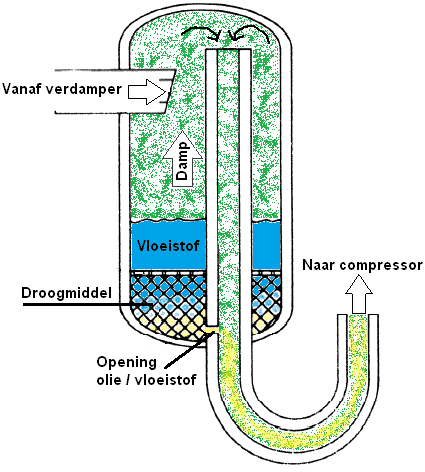Subjects:
- General
- Operation
General:
An accumulator has in the air conditioning system the tasks of converting the last liquid droplets of the refrigerant into gaseous form, removing moisture from the refrigerant and adding oil. The accumulator is mounted on the low pressure side in the system, between the evaporator and the compressor. The accumulator is only fitted in air conditioning systems with a capillary. (The other version is with a TEV valve, but there is no accumulator there, but a filter / dryer mounted). The capillary's job is to lower the pressure of the system, causing the refrigerant to evaporate. Unfortunately, the capillary is not always able to convert all the refrigerant from liquid to vapor. Liquid droplets always remain behind, which then end up in the accumulator via the low-pressure part of the system. These droplets are evaporated in the accumulator. It is very important that all liquid droplets have evaporated before the refrigerant reaches the compressor. If the amount of liquid is too large, the compressor makes a so-called 'liquid hammer' and can break down as a result. After all, liquid cannot be compressed (compressible). The accumulator is often also mounted on hot engine parts. As a result, the accumulator is internally heated, so that the evaporation of the liquid droplets also goes faster.
Operation:
The refrigerant enters from the evaporator at the top of the accumulator. The present droplets and the oil fall to the bottom and end up in the fluid reservoir. The vapor remains suspended at the top and is then sucked in through the central pipe by the compressor (by underpressure). At the bottom of the accumulator is a desiccant, which has the same effect as that of a filter / dryer in a TEV system. The moisture present is absorbed into the desiccant. The oil present (the lubricating oil for the compressor) gradually sinks through the desiccant and collects at the opening at the bottom of the tube. The oil is gradually drawn in by the venturi action, as the gases in the tube move outwards (creating negative pressure in the opening). In this way, oil is gradually added to the refrigerant, because too much oil can damage the compressor.
Click here to go to the air conditioning page.

